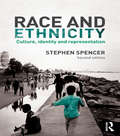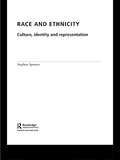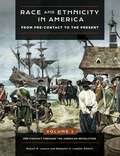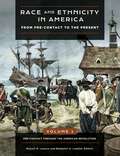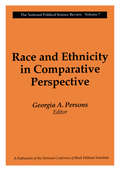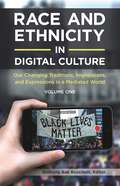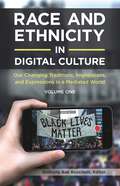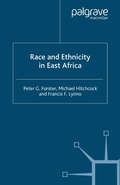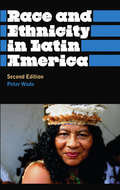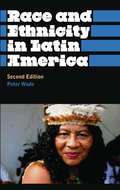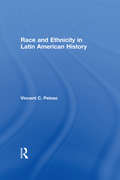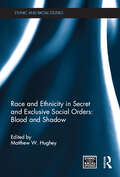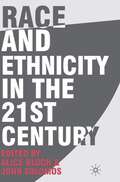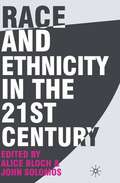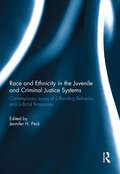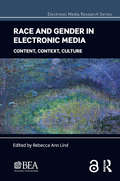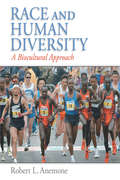- Table View
- List View
Race and Ethnicity: Culture, Identity and Representation
by Stephen SpencerBroad-ranging and comprehensive, this completely revised and updated textbook is a critical guide to issues and theories of ‘race’ and ethnicity. It shows how these concepts came into being during colonial domination and how they became central – and until recently, unquestioned – aspects of social identity and division. This book provides students with a detailed understanding of colonial and post-colonial constructions, changes and challenges to race as a source of social division and inequality. Drawing upon rich international case studies from Australia, Guyana, Canada, Malaysia, the Caribbean, Mexico, Ireland and the UK, the book clearly explains the different strands of theory which have been used to explain the dynamics of race. These are critically scrutinised, from biological-based ideas to those of critical race theory. This key text includes new material on changing multiculturalism, immigration and fears about terrorism, all of which are critically assessed. Incorporating summaries, chapter-by-chapter questions, illustrations, exercises and a glossary of terms, this student-friendly text also puts forward suggestions for further project work. Broad in scope, interactive and accessible, this book is a key resource for undergraduate students of 'race' and ethnicity across the social sciences.
Race and Ethnicity: Culture, Identity and Representation
by Stephen SpencerBroad-ranging and comprehensive, this completely revised and updated textbook is a critical guide to issues and theories of ‘race’ and ethnicity. It shows how these concepts came into being during colonial domination and how they became central – and until recently, unquestioned – aspects of social identity and division. This book provides students with a detailed understanding of colonial and post-colonial constructions, changes and challenges to race as a source of social division and inequality. Drawing upon rich international case studies from Australia, Guyana, Canada, Malaysia, the Caribbean, Mexico, Ireland and the UK, the book clearly explains the different strands of theory which have been used to explain the dynamics of race. These are critically scrutinised, from biological-based ideas to those of critical race theory. This key text includes new material on changing multiculturalism, immigration and fears about terrorism, all of which are critically assessed. Incorporating summaries, chapter-by-chapter questions, illustrations, exercises and a glossary of terms, this student-friendly text also puts forward suggestions for further project work. Broad in scope, interactive and accessible, this book is a key resource for undergraduate students of 'race' and ethnicity across the social sciences.
Race and Ethnicity: Culture, Identity and Representation
by Stephen SpencerBroad-ranging and comprehensive, this incisive new textbook examines the shifting meanings of 'race' and ethnicity and collates the essential concepts in one indispensable companion volume. From Marxist views to post-colonialism, this book investigates the attendant debates, issues and analyses within the context of global change. Using international case studies from Australia, Malaysia, the Caribbean, Mexico and the UK and examples of popular imagery that help to explain the more difficult elements of theory, this key text focuses on everyday life issues such as: ethnic conflicts and polarized states racism(s) and policies of multiculturalism diasporas, asylum seekers and refugees mixed race and hybrid identity Incorporating summaries, questions, illustrations, exercises and a glossary of terms, this student-friendly text also puts forward suggestions for further project work. Broad in scope, interactive and accessible, this book is a key resource for undergraduate and postgraduate level students of 'race' and ethnicity across the social sciences.
Race and Ethnicity: Culture, Identity and Representation
by Stephen SpencerBroad-ranging and comprehensive, this incisive new textbook examines the shifting meanings of 'race' and ethnicity and collates the essential concepts in one indispensable companion volume. From Marxist views to post-colonialism, this book investigates the attendant debates, issues and analyses within the context of global change. Using international case studies from Australia, Malaysia, the Caribbean, Mexico and the UK and examples of popular imagery that help to explain the more difficult elements of theory, this key text focuses on everyday life issues such as: ethnic conflicts and polarized states racism(s) and policies of multiculturalism diasporas, asylum seekers and refugees mixed race and hybrid identity Incorporating summaries, questions, illustrations, exercises and a glossary of terms, this student-friendly text also puts forward suggestions for further project work. Broad in scope, interactive and accessible, this book is a key resource for undergraduate and postgraduate level students of 'race' and ethnicity across the social sciences.
Race and Ethnicity in America [4 volumes]: From Pre-contact to the Present [4 volumes]
by Russell M. Lawson and Benjamin A. Lawson, EditorsDivided into four volumes, Race and Ethnicity in America provides a complete overview of the history of racial and ethnic relations in America, from pre-contact to the present.The five hundred years since Europeans made contact with the indigenous peoples of America have been dominated by racial and ethnic tensions. During the colonial period, from 1500 to 1776, slavery and servitude of whites, blacks, and Indians formed the foundation for race and ethnic relations. After the American Revolution, slavery, labor inequalities, and immigration led to racial and ethnic tensions; after the Civil War, labor inequalities, immigration, and the fight for civil rights dominated America's racial and ethnic experience. From the 1960s to the present, the unfulfilled promise of civil rights for all ethnic and racial groups in America has been the most important sociopolitical issue in America. Race and Ethnicity in America tells this story of the fight for equality in America. The first volume spans pre-contact to the American Revolution; the second, the American Revolution to the Civil War; the third, Reconstruction to the Civil Rights Movement; and the fourth, the Civil Rights Movement to the present. All volumes explore the culture, society, labor, war and politics, and cultural expressions of racial and ethnic groups.
Race and Ethnicity in America [4 volumes]: From Pre-contact to the Present [4 volumes]
Divided into four volumes, Race and Ethnicity in America provides a complete overview of the history of racial and ethnic relations in America, from pre-contact to the present.The five hundred years since Europeans made contact with the indigenous peoples of America have been dominated by racial and ethnic tensions. During the colonial period, from 1500 to 1776, slavery and servitude of whites, blacks, and Indians formed the foundation for race and ethnic relations. After the American Revolution, slavery, labor inequalities, and immigration led to racial and ethnic tensions; after the Civil War, labor inequalities, immigration, and the fight for civil rights dominated America's racial and ethnic experience. From the 1960s to the present, the unfulfilled promise of civil rights for all ethnic and racial groups in America has been the most important sociopolitical issue in America. Race and Ethnicity in America tells this story of the fight for equality in America. The first volume spans pre-contact to the American Revolution; the second, the American Revolution to the Civil War; the third, Reconstruction to the Civil Rights Movement; and the fourth, the Civil Rights Movement to the present. All volumes explore the culture, society, labor, war and politics, and cultural expressions of racial and ethnic groups.
Race and Ethnicity in Comparative Perspective
by Georgia A. PersonsContradictory forces are at play at the close of the twentieth century. There is a growing closeness of peoples fueled by old and new technologies of modern aviation, digital-based communications, new patterns of trade and commerce, and growing affluence of significant portions of the world's population. Television permits individuals around the world to learn about the cultures and lifestyles of peoples of physically distant lands. These developments give real meaning to the notion of a global village. Peoples of the world are growing closer in new and increasingly important ways.Nonetheless, there are disturbing signs of a growing awareness of ethnic differences in all parts of the world the United States included and a concomitant rise in ethnic-based conflicts, many of them extraordinarily violent in nature. Fear, resentment, intoler-ance, and mistreatment of the "other" abound in world news accounts. Not only does this phenomenon pose an interesting juxtaposition to the concept of the emergent glo-bal village, but its emergence in the post-cold war era internationally and the post-civil rights era in the United States raises significant and compelling questions. Why are such conflicts occurring now? How do analysts explain these developments?The essays in Race and Ethnicity in Comparative Perspective lucidly explore some of the complexities of the persistence and re-emergence of race and ethnicity as major lines of divisiveness around the world. Contributors analyze manifestations of race-based movements for political empowerment in Europe and Latin America as well as racial intolerance in these same settings. Attention is also given to the conceptual complexi-ties of multidimensional and shared cultural roots of the overlapping phenomena of ethnicity, nationalism, identity, and ideology. The book greatly informs discussions of race and ethnicity in the international context and provides an interesting perspective against which to view America's changing problem of race. Race and Ethnicity in Com-parative Perspective is a timely, thought-provoking volume that will be of immense value to ethnic studies specialists, African American studies scholars, political scientists, his-torians, and sociologists.
Race and Ethnicity in Comparative Perspective
by Georgia A. PersonsContradictory forces are at play at the close of the twentieth century. There is a growing closeness of peoples fueled by old and new technologies of modern aviation, digital-based communications, new patterns of trade and commerce, and growing affluence of significant portions of the world's population. Television permits individuals around the world to learn about the cultures and lifestyles of peoples of physically distant lands. These developments give real meaning to the notion of a global village. Peoples of the world are growing closer in new and increasingly important ways.Nonetheless, there are disturbing signs of a growing awareness of ethnic differences in all parts of the world the United States included and a concomitant rise in ethnic-based conflicts, many of them extraordinarily violent in nature. Fear, resentment, intoler-ance, and mistreatment of the "other" abound in world news accounts. Not only does this phenomenon pose an interesting juxtaposition to the concept of the emergent glo-bal village, but its emergence in the post-cold war era internationally and the post-civil rights era in the United States raises significant and compelling questions. Why are such conflicts occurring now? How do analysts explain these developments?The essays in Race and Ethnicity in Comparative Perspective lucidly explore some of the complexities of the persistence and re-emergence of race and ethnicity as major lines of divisiveness around the world. Contributors analyze manifestations of race-based movements for political empowerment in Europe and Latin America as well as racial intolerance in these same settings. Attention is also given to the conceptual complexi-ties of multidimensional and shared cultural roots of the overlapping phenomena of ethnicity, nationalism, identity, and ideology. The book greatly informs discussions of race and ethnicity in the international context and provides an interesting perspective against which to view America's changing problem of race. Race and Ethnicity in Com-parative Perspective is a timely, thought-provoking volume that will be of immense value to ethnic studies specialists, African American studies scholars, political scientists, his-torians, and sociologists.
Race and Ethnicity in Digital Culture [2 volumes]: Our Changing Traditions, Impressions, and Expressions in a Mediated World [2 volumes]
by Anthony Bak Buccitelli, EditorIn this unprecedented study, leading scholars and emerging voices from around the world consider how race and ethnicity continue to shape our everyday lives, even as digital technology seems to promise a release from our "real" social identities.How do people use the new expressive features of digital technologies to experience, represent, discuss, and debate racial and ethnic identity? How have digital technologies or digital spaces become racialized? How have the existing vernacular traditions, or folklore, surrounding identity been reshaped in digital spaces? And how have new traditions emerged? This interdisciplinary volume of essays explores the role of traditional culture in the evolving expressions, practices, and images of race and ethnicity in the digital age. The work examines cultural forms in exclusively digital environments as well as in the hybrid environments created by mobile technologies, where real life becomes overlaid with digital content.Insights from academics across disciplines—including anthropology, communications, folkloristics, art, and sociology—consider the interplay between race/ethnicity, everyday vernacular culture, and digital technologies. Six sections explore traditional cultural affordances of technology, folklore and digital applications, visual cultures of race and ethnicity, racism and exclusion online, political activism and race, and concluding observations. The book covers technologies such as vlogs, video games, digital photography, messaging applications, social media sites, and the Internet.
Race and Ethnicity in Digital Culture [2 volumes]: Our Changing Traditions, Impressions, and Expressions in a Mediated World [2 volumes]
In this unprecedented study, leading scholars and emerging voices from around the world consider how race and ethnicity continue to shape our everyday lives, even as digital technology seems to promise a release from our "real" social identities.How do people use the new expressive features of digital technologies to experience, represent, discuss, and debate racial and ethnic identity? How have digital technologies or digital spaces become racialized? How have the existing vernacular traditions, or folklore, surrounding identity been reshaped in digital spaces? And how have new traditions emerged? This interdisciplinary volume of essays explores the role of traditional culture in the evolving expressions, practices, and images of race and ethnicity in the digital age. The work examines cultural forms in exclusively digital environments as well as in the hybrid environments created by mobile technologies, where real life becomes overlaid with digital content.Insights from academics across disciplines—including anthropology, communications, folkloristics, art, and sociology—consider the interplay between race/ethnicity, everyday vernacular culture, and digital technologies. Six sections explore traditional cultural affordances of technology, folklore and digital applications, visual cultures of race and ethnicity, racism and exclusion online, political activism and race, and concluding observations. The book covers technologies such as vlogs, video games, digital photography, messaging applications, social media sites, and the Internet.
Race and Ethnicity in East Africa
by P. Forster M. Hitchcock F. LyimoRace and ethnicity continue to be important, if unwelcome, factors in modern politics. This is evident in East Africa: the ethnic factor is often dominant in multi-party elections, while in Rwanda and Burundi bloodshed and genocidal attacks have been linked to ethnic difference. This book examines the phenomena of race and ethnicity in general, but with particular reference to Africa, especially the East. The impact of non-indigenous groups is considered, together with ethnic differences between Africans. The relevance of tourism and religion is also examined.
Race and Ethnicity in Latin America (Anthropology, Culture and Society)
by Peter WadeFor over ten years, Race and Ethnicity in Latin America has been an essential text for students studying the region. This second edition adds new material and brings the analysis up to date.*BR**BR*Race and ethnic identities are increasingly salient in Latin America. Peter Wade examines changing perspectives on Black and Indian populations in the region, tracing similarities and differences in the way these peoples have been seen by academics and national elites. Race and ethnicity as analytical concepts are re-examined in order to assess their usefulness.*BR**BR*This book should be the first port of call for anthropologists and sociologists studying identity in Latin America.
Race and Ethnicity in Latin America (Anthropology, Culture and Society)
by Peter WadeFor over ten years, Race and Ethnicity in Latin America has been an essential text for students studying the region. This second edition adds new material and brings the analysis up to date.*BR**BR*Race and ethnic identities are increasingly salient in Latin America. Peter Wade examines changing perspectives on Black and Indian populations in the region, tracing similarities and differences in the way these peoples have been seen by academics and national elites. Race and ethnicity as analytical concepts are re-examined in order to assess their usefulness.*BR**BR*This book should be the first port of call for anthropologists and sociologists studying identity in Latin America.
Race and Ethnicity in Latin American History
by Vincent PelosoThe Spanish and Portuguese empires that existed in the Americas for over three hundred years resulted in the creation of a New World population in which a complex array of racial and ethnic distinctions were embedded in the discourse of power. During the colonial era, racial and ethnic identities were publicly acknowledged by the state and the Church, and subject to stringent codes that shaped both individual lives and the structures of society. The legacy of these distinctions continued after independence, as race and ethnicity continued to form culturally defined categories of social life. In Race and Ethnicity in Latin American History, Vincent Peloso traces the story of ethnicity and race in Latin America from the sixteenth century to the contemporary period. In a short, synthetic narrative, he lays the groundwork for students to understand how the history of colonial racism is connected to the problems of racism in today’s Latin American societies. With features including timelines, plentiful maps and illustrations, and boxes highlighting important historical figures, the text provides a clear and accessible introduction to the complex subject of race and ethnicity in the history of Latin America.
Race and Ethnicity in Latin American History
by Vincent PelosoThe Spanish and Portuguese empires that existed in the Americas for over three hundred years resulted in the creation of a New World population in which a complex array of racial and ethnic distinctions were embedded in the discourse of power. During the colonial era, racial and ethnic identities were publicly acknowledged by the state and the Church, and subject to stringent codes that shaped both individual lives and the structures of society. The legacy of these distinctions continued after independence, as race and ethnicity continued to form culturally defined categories of social life. In Race and Ethnicity in Latin American History, Vincent Peloso traces the story of ethnicity and race in Latin America from the sixteenth century to the contemporary period. In a short, synthetic narrative, he lays the groundwork for students to understand how the history of colonial racism is connected to the problems of racism in today’s Latin American societies. With features including timelines, plentiful maps and illustrations, and boxes highlighting important historical figures, the text provides a clear and accessible introduction to the complex subject of race and ethnicity in the history of Latin America.
Race and Ethnicity in Secret and Exclusive Social Orders: Blood and Shadow (Ethnic and Racial Studies)
by Matthew W. HugheySecret and private organizations, in the form of Greek-letter organizations, mutual aid societies, and civic orders, together possess a storied and often-romanticized place in popular culture. While much has been made of these groups’ glamorous origins and influence—such as the Freemasons’ genesis in King Solomon’s temple or the belief in the Illuminati’s control of modern geo-politics—few have explicitly examined the role of race and ethnicity in organizing and perpetuating these cloistered orders. This volume directly addresses the inattention paid to the salience of race in secret societies. Through an examination of the Historically Black and White Fraternities and Sororities, the Ku Klux Klan in the US, the Ekpe and Abakuj secret societies of Africa and the West Indies, Gypsies in the United Kingdom, Black and White Temperance Lodges, and African American Order of the Elks, this book traces the use of racial and ethnic identity in these organizations. This important contribution examines how such orders are both cause and consequence of colonization, segregation, and subjugation, as well as their varied roles as both catalysts and impediments to developing personal excellence, creating fictive kinship ties, and fostering racial uplift, nationalism, and cohesion.This book was originally published as a special issue of Ethnic and Racial Studies.
Race and Ethnicity in Secret and Exclusive Social Orders: Blood and Shadow (Ethnic and Racial Studies)
by Matthew W. HugheySecret and private organizations, in the form of Greek-letter organizations, mutual aid societies, and civic orders, together possess a storied and often-romanticized place in popular culture. While much has been made of these groups’ glamorous origins and influence—such as the Freemasons’ genesis in King Solomon’s temple or the belief in the Illuminati’s control of modern geo-politics—few have explicitly examined the role of race and ethnicity in organizing and perpetuating these cloistered orders. This volume directly addresses the inattention paid to the salience of race in secret societies. Through an examination of the Historically Black and White Fraternities and Sororities, the Ku Klux Klan in the US, the Ekpe and Abakuj secret societies of Africa and the West Indies, Gypsies in the United Kingdom, Black and White Temperance Lodges, and African American Order of the Elks, this book traces the use of racial and ethnic identity in these organizations. This important contribution examines how such orders are both cause and consequence of colonization, segregation, and subjugation, as well as their varied roles as both catalysts and impediments to developing personal excellence, creating fictive kinship ties, and fostering racial uplift, nationalism, and cohesion.This book was originally published as a special issue of Ethnic and Racial Studies.
Race and Ethnicity in the 21st Century
by John Solomos Alice BlochIn the 21st century, new ethnic groups are forming faster than ever before and the role of race and ethnicity studies has evolved in response to this. From policy issues around housing and crime, through to debates about asylum and media representations, sociologists must encounter and explore a vast range of issues in this ever changing field.This book gives an overview of the most important topics that affect the making of race and ethnic relations in contemporary societies. It goes beyond general definitions to explain exactly how and what these issues and debates can tell us about modern society. Using research and statistics to shed light on the most cutting-edge issues, the book takes each major topic in turn and helps readers to think through race and ethnicity on the basis of the most recent thinking in the field. Each chapter explains a range of theoretical and conceptual perspectives, whilst approaching complex ideas in an accessible and insightful way.Written and edited by recognized experts in the field, Race and Ethnicity in the 21st Century will be an essential point of reference for researchers and practitioners and key reading for all students of race and ethnicity.
Race and Ethnicity in the 21st Century (PDF)
by Alice Bloch John SolomosIn the 21st century, new ethnic groups are forming faster than ever before and the role of race and ethnicity studies has evolved in response to this. From policy issues around housing and crime, through to debates about asylum and media representations, sociologists must encounter and explore a vast range of issues in this ever changing field. This book gives an overview of the most important topics that affect the making of race and ethnic relations in contemporary societies. It goes beyond general definitions to explain exactly how and what these issues and debates can tell us about modern society. Using research and statistics to shed light on the most cutting-edge issues, the book takes each major topic in turn and helps readers to think through race and ethnicity on the basis of the most recent thinking in the field. Each chapter explains a range of theoretical and conceptual perspectives, whilst approaching complex ideas in an accessible and insightful way. Written and edited by recognized experts in the field, Race and Ethnicity in the 21st Century will be an essential point of reference for researchers and practitioners and key reading for all students of race and ethnicity.
Race and Ethnicity in the Juvenile and Criminal Justice Systems: Contemporary issues of offending behavior and judicial responses
by Jennifer H. PeckOver the last few decades, the racial and ethnic composition of the United States has changed dramatically. This seismic transformation has important implications for theory, research, policy, and public opinion – perhaps most crucially around the topic of race/ethnicity and our justice systems. Recent national events – from Ferguson, to ferocious public debate about racism, to media depictions of police violence – have reawakened the tense question of race relations in the 21st century. This edited collection of research aims to highlight contemporary issues surrounding the overrepresentation of racial and ethnic minorities throughout both the juvenile and adult criminal justice systems. Our contributors cover both formal sources of social control (e.g. police, courts, correction facilities) and perceptions and public opinions of the relationship between race/ethnicity and offending behaviors. As the intellectual sphere ignites with fresh debate, old questions redefined and new ones asked, this publication provides innovative insight into how race and ethnicity interconnect with all aspects of criminology and criminal justice. Furthermore it helps encourage directions for future research, practice, and public policy. This book was originally published as a special issue of the Journal of Crime and Justice.
Race and Ethnicity in the Juvenile and Criminal Justice Systems: Contemporary issues of offending behavior and judicial responses
by Jennifer H. PeckOver the last few decades, the racial and ethnic composition of the United States has changed dramatically. This seismic transformation has important implications for theory, research, policy, and public opinion – perhaps most crucially around the topic of race/ethnicity and our justice systems. Recent national events – from Ferguson, to ferocious public debate about racism, to media depictions of police violence – have reawakened the tense question of race relations in the 21st century. This edited collection of research aims to highlight contemporary issues surrounding the overrepresentation of racial and ethnic minorities throughout both the juvenile and adult criminal justice systems. Our contributors cover both formal sources of social control (e.g. police, courts, correction facilities) and perceptions and public opinions of the relationship between race/ethnicity and offending behaviors. As the intellectual sphere ignites with fresh debate, old questions redefined and new ones asked, this publication provides innovative insight into how race and ethnicity interconnect with all aspects of criminology and criminal justice. Furthermore it helps encourage directions for future research, practice, and public policy. This book was originally published as a special issue of the Journal of Crime and Justice.
Race and Gender in Electronic Media: Content, Context, Culture (Electronic Media Research Series)
by Rebecca Ann LindThis volume examines the consequences, implications, and opportunities associated with issues of diversity in the electronic media. With a focus on race and gender, the chapters represent diverse approaches, including social scientific, humanistic, critical, and rhetorical. The contributors consider race and gender issues in both historical and contemporary electronic media, and their work is presented in three sections: content, context (audiences, effects, and reception), and culture (media industries, policy, and production). In this book, the authors investigate, problematize, and theorize a variety of concerns which at their core relate to issues of difference. How do we use media to construct and understand different social groups? How do the media represent and affect our engagement with and responses to different social groups? How can we understand these processes and the environment within which they occur? Although this book focuses on the differences associated with race and gender, the questions raised by and the theoretical perspectives presented in the chapters are applicable to other forms of socially-constructed difference. Chapters 5, 10, 12, and 19 of this book are freely available as downloadable Open Access PDFs at http://www.taylorfrancis.com under a Creative Commons Attribution-Non Commercial-No Derivatives (CC-BY-NC-ND) 4.0 license.
Race and Gender in Electronic Media: Content, Context, Culture (Electronic Media Research Series)
by Rebecca Ann LindThis volume examines the consequences, implications, and opportunities associated with issues of diversity in the electronic media. With a focus on race and gender, the chapters represent diverse approaches, including social scientific, humanistic, critical, and rhetorical. The contributors consider race and gender issues in both historical and contemporary electronic media, and their work is presented in three sections: content, context (audiences, effects, and reception), and culture (media industries, policy, and production). In this book, the authors investigate, problematize, and theorize a variety of concerns which at their core relate to issues of difference. How do we use media to construct and understand different social groups? How do the media represent and affect our engagement with and responses to different social groups? How can we understand these processes and the environment within which they occur? Although this book focuses on the differences associated with race and gender, the questions raised by and the theoretical perspectives presented in the chapters are applicable to other forms of socially-constructed difference. Chapters 5, 10, 12, and 19 of this book are freely available as downloadable Open Access PDFs at http://www.taylorfrancis.com under a Creative Commons Attribution-Non Commercial-No Derivatives (CC-BY-NC-ND) 4.0 license.
Race and Human Diversity: A Biocultural Approach, CourseSmart eTextbook
by Robert L. AnemoneRace and Human Diversity is an introduction to the study of Human Diversity in both its biological and cultural dimensions. This text examines the biological basis of human difference and how humans have biologically and culturally adapted to life in different environments. It critiques the notion that humans can or should be classified into a number of "biological races". Coverage includes discussion of the following topics: Biological background of human variation History of racial classification A critique of the Race Concept Ethnic disease: How race affects morbidity and morality Adapative dimensions of human variability: Life in the tropics, the arctic, and high altitude Physiology of skin color A critical history of attempts to link race and intelligence Race as a cultural construct
Race and Human Diversity: A Biocultural Approach, CourseSmart eTextbook
by Robert L. AnemoneRace and Human Diversity is an introduction to the study of Human Diversity in both its biological and cultural dimensions. This text examines the biological basis of human difference and how humans have biologically and culturally adapted to life in different environments. It critiques the notion that humans can or should be classified into a number of "biological races". Coverage includes discussion of the following topics: Biological background of human variation History of racial classification A critique of the Race Concept Ethnic disease: How race affects morbidity and morality Adapative dimensions of human variability: Life in the tropics, the arctic, and high altitude Physiology of skin color A critical history of attempts to link race and intelligence Race as a cultural construct
